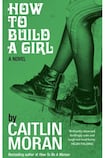
In 2011 Caitlin Moran wrote a book she described as targeting an open goal. No, not a treatise on sport – although, given the wealth of topics on which Moran regularly opines, it wouldn't have been a surprise. In How to Be a Woman, the British newspaper columnist blended biography and feminism and lassoed a dedicated audience of women, uniting them in air-punching against the patriarchy.
It was brash and funny and was credited with introducing a swathe of younger women to feminism. It also sold a lot of copies. This was not Julia Kristeva or Kate Millett but a punk-rock philosophy of bodily autonomy and combating sexism.
In How to Build a Girl we meet Johanna Morrigan, a teenage girl whose fictional life so closely mirrors Moran's – Moran grew up in a large family with little money, was overweight and anxious, and longed to be a writer – that it is difficult to separate the two. Johanna is burdened with teenage anxieties – weight issues, desperation to lose her virginity – while gorging on TV and books, and writing terrible poetry.
Her unemployed but able father once aspired to be a musician but is now a drinker who oversees the children’s cultural education. In a moment of rueful oversharing she tells a neighbour that the family rely on benefits, then realises that this admission may jeopardise their already precarious finances.
When not hovering by the letterbox to intercept any dole-threat notices, Johanna lurks in bed, using her deodorant bottle as a sex toy.
Blunt
In this blunt-as-hell Bildungsroman Moran traces a hilarious, embarrassment-heavy image of adolescence. Johanna reinvents and “collages” herself as Dolly Wilde, pinning pictures of heroes – George Orwell, Elizabeth Taylor,
Rik Mayall
as Lord Flashheart in
Blackadder
– on her wall like an incident-room detective. When Dolly/Johanna heads for London and immerses herself in partying, music and journalism, readers must remind themselves that this book has an author’s note disclaiming the overlap in Moran’s real and Johanna’s fictional lives.
The main problem here is voice. If you have read anything else by Moran, whether How to Be a Woman or her vibrant, wisecracking journalism, Dolly/Johanna feels less like a novelistic creation and more like Moran's mouthpiece and fictional doppelganger.
When Dolly is dispatched to an interview in Dublin she transports a pint of Guinness back to England for her Irish father – a true story that Moran regularly tells. Many other moments also mirror Moran’s life, and it’s this lack of separation between fact and fiction that makes the book less convincing as a novel.
That’s not to say it doesn’t zing with humour. The barrage of one-liners is constant, and Moran brilliantly captures the complexities and contradictions of teenage life, from sex and shyness to gender and pop culture. “Record shops are not for womenfolk . . . they are the young, music-loving person’s equivalent of the gentleman’s smoking room.”
Johanna's story pivots from cultural reconnaissance – John Peel, The Country Girls by Edna O'Brien – to personal exploration. These streams often cross, just as they do in her beloved Ghostbusters. She attempts to learn S&M by watching Madonna's Justify My Love video; this is Adrian Mole with a better soundtrack and more onanism.
Filthy
There is a dearth of contemporary novels about being young and working class, and this book’s examination of class and poverty is unsentimental. Sex and class are inextricably political: when Johanna begins a relationship with a “posh” man he repeatedly calls her “filthy”, and she overhears herself referred to as his “bit of rough”. Johanna starts the book as a girl who wants to be saved but slowly realises that she can save herself. There is no doubting that Moran can write, but the subject feels like overly familiar, well-trodden ground.
It's difficult not to conjure up Germaine, the teenage protagonist from Moran's debut TV series, Raised By Wolves, when reading Johanna's life, or to hear Moran herself. (All of chapter 24 could have come verbatim from How to Be a Woman.) But one can't help falling for the aspirant pun-slinging Johanna. How to Build a Girl is a hugely entertaining rebel yell – and you'll never think of a Blue Peter snake-handler in the same way after reading it.











